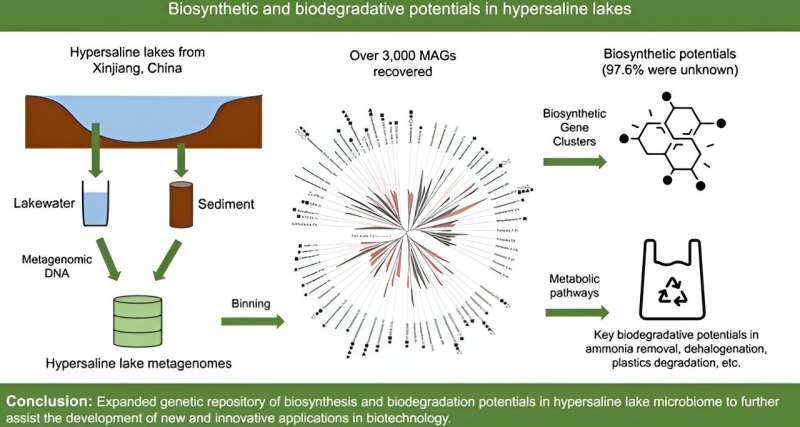Credit: Environmental Science and Ecotechnology (2023). DOI: 10.1016/j.ese.2023.100359
A recent study published in the journal Environmental Science and Ecotechnology explores the largely unknown metabolic capabilities of unclassified microbial species in extreme environments, particularly hypersaline lakes, and their potential applications in biotechnology, medicine, and environmental remediation.
In this detailed study, researchers embarked on a scientific adventure to the salt-rich lakes of Xinjiang, China, aiming to explore the largely unknown world of microbial dark matters. These are microbes that thrive in environments with high levels of salt, which have not been classified due to their elusive nature.
Utilizing advanced DNA sequencing techniques, the team cataloged an astonishing variety of more than 3,000 metagenome-assembled genomes (MAGs) from 82 different families, most of which are new to science. They unearthed more than 9,000 unique biosynthesis gene clusters, 94% of which are novel, indicating a vast, untapped potential for new biological discoveries.
This research not only expands our knowledge of life in extreme conditions but also opens exciting possibilities for new technologies and medical breakthroughs, leveraging the untapped resources of these unique microbial communities.
Ke Yu, the study's lead researcher, emphasized the significance of these discoveries for biotechnology and environmental remediation, highlighting the untapped potential of microbial dark matters in extreme environments.
The findings open new avenues for biotechnological innovation, emphasizing the untapped potential of microbial diversity in extreme environments. The discovery of novel biosynthesis pathways and biodegradation capabilities in these microbial communities can have far-reaching implications for developing new drugs, biotechnological processes, and environmental remediation methods.
More information: Zhiguang Qiu et al, Unravelling biosynthesis and biodegradation potentials of microbial dark matters in hypersaline lakes, Environmental Science and Ecotechnology (2023). DOI: 10.1016/j.ese.2023.100359
Provided by Chinese Academy of Sciences























